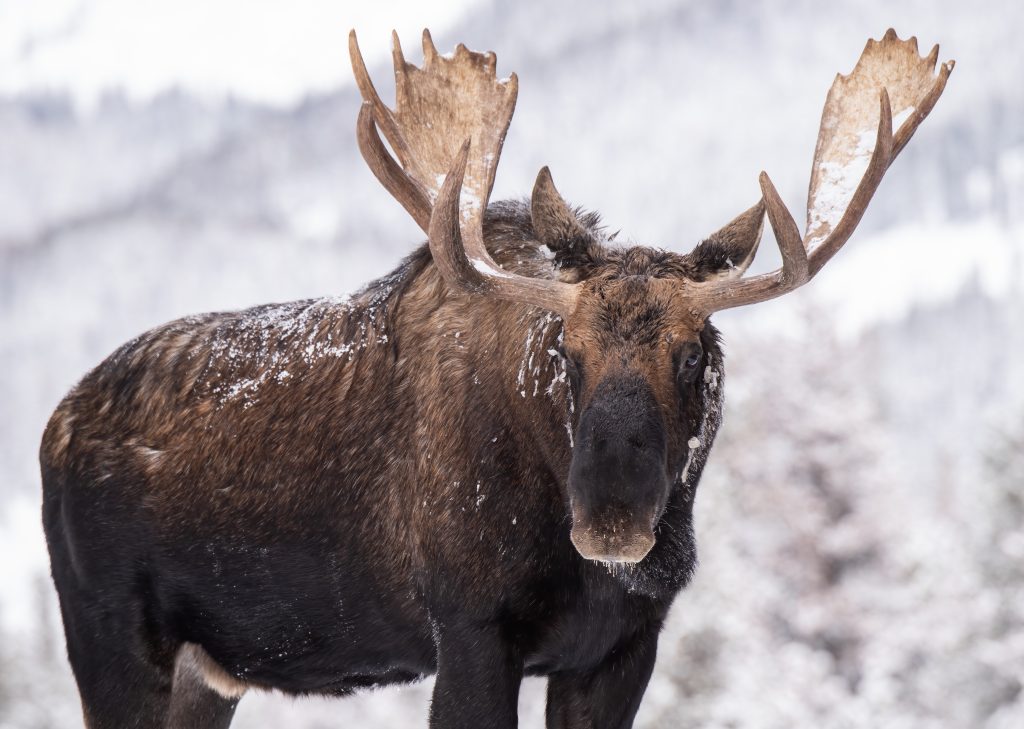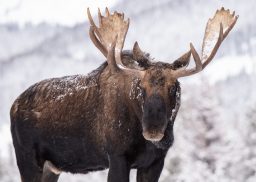Moose don’t actively seek out humans for attack. They will charge at humans who get too close or will often just kick them – so it pays to know your moose!
Why Do Moose Attack Humans?
Moose attack humans because this is the way they communicate their frustration. If you are in their way; you don’t do what they want you to do; or you are scaring them – they attack first.

Usually the attack itself is more of a one-off charge or kick – but moose injure more humans in a year than bears do in North America – usually because more people approach a moose than they would a bear. Their mistake!
Moose are often just trying to get out of the heat or find something to eat – so if they are standing still on a path, by a building or a house – they are tired. If you start shooing them to move someplace else; you get too close; or you are trying to touch them – this is going to make them grouchy. Moose can kick out in ALL directions from a standing start – and they have very long legs.
So, if you can touch them – they can seriously injure you in a second.
Also, during the fall rut and in the spring calving season, tensions are high in the moose world.
They won’t tolerate perceived threats at this time and are what could be described as ‘on edge’. The problem for most people who get injured is that moose don’t react negatively while you are far away, even if you are actually annoying them – they just wait where they are and hope that you go away. But people take this ‘staying still’ as a sign that moose are friendly – and end up moving closer. Big mistake.
Signs Of A Moose Attack:
You don’t always get all the signs listed below before an attack – but watch out for any of the following signs of an impending moose charge. Be ready to run:
- Maintaining Eye Contact
- Lowering Their Ears
- Huffing Or Lip Licking
- Stamping Their Feet
- Walking Towards You
- Urinating
- Flicking Up Their Head
- Raising Their Hackles
Don’t wait for any of these of course before reacting. If you find yourself suddenly within a stone’s throw of a moose of any size – back off fast.
Do Wolves Have a Higher Chance of Attacking Humans Compared to Moose?
When considering wolves’ aggression towards humans in perspective, it’s crucial to compare it with other wildlife, such as moose. While rare, wolf attacks on humans do occur, with a higher chance than moose. However, it’s essential to note that humans are not typically seen as prey by either species, and the risk can be greatly minimized by practicing safe outdoor habits and respecting wildlife boundaries.
How To Avoid A Moose Attack:
The only way to avoid a moose attack is to not go near them – obvious really. There is no reason at all why a human should ever move closer towards a large wild animal – so most of the tips below are for those who find themselves face to face with a moose in a more urban area or on a wildlife trail.
1: Move Away:
If you can move away from the moose, then do that. if there is an alternate routeway or you can walk back indoors – choose that option. No-one ever really needs to go a specific way right that moment. You are outdoors and usually on vacation – so enjoy the moment.
2: Wait A While:
If you can’t go round, then wait well back. Moose can run as fast as a horse from a standing start; so you need to be far enough away to run behind a large tree before it reaches you. Don’t make loud noises or try to scare them off – it doesn’t work anyways.
3: Control The Hound:
Moose really don’t like dogs. They often go out of their way to kick one (according to many different Fish & Wildlife advisory services) – so it is best to keep your dogs on a leash in urban moose areas, and stay out of their way. Do not approach a moose with a dog close by.
4: Don’t Feed Moose:
Moose love to eat food given by humans – and they think all humans will feed them. So when they approach a human who DOESN’T feed them they get a bit annoyed and can attack.
You may think you are ‘helping’ one moose by feeding it once or twice – but you are actually creating a potential risk. If it becomes a local pest and end up injuring people – it may well be shot by local authorities as a safeguard.
5: Avoid Baby Moose:
Moose moms love their babies and will do anything for them – that includes charging down humans. They can really ramp up their aggression during this time and maybe far more unpredictable than normal – taking tourists by surprise.
It isn’t wise to approach any baby animals anyway – even if they appear alone. The parents usually aren’t far away.









